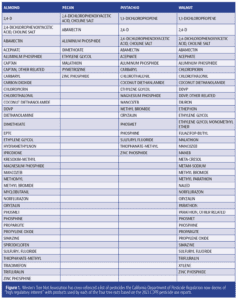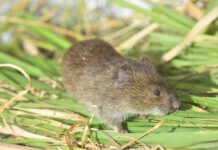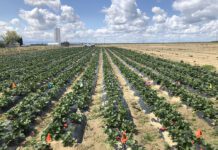Listen to the audio version of this article. (Generated by A.I.)
In a recent announcement that grant funding opportunities for Sustainable Pest Management (SPM) had opened, the California Department of Pesticide Regulation (CDPR) announced a list of pesticides of “high regulatory interest.” Coincidentally, over the past couple years, CDPR has worked on its new effort to regulate pesticides under the auspices of the SPM program. Now, with the release of this list, we know which pesticides will be targeted.
To get started, it might be good to refresh our minds on what the SPM movement is. According to CDPR, SPM is “a holistic, whole system approach to managing pests in agriculture and other managed ecosystems and urban and rural communities that builds on the concept of integrated pest management (IPM) with broader consideration of human health and social equity, environmental protections and economic vitality.” CDPR says they developed the SPM Roadmap to guide the agency for the next 20 years to achieve sustainable pest management. In the roadmap, CDPR asserts as their No. 1 goal “by 2050 California has eliminated the use of Priority Pesticides by transitioning to sustainable pest management practices”.
‘…[California Department of Pesticide Regulation] asserts as their No. 1 goal “by 2050 California has eliminated the use of Priority Pesticides by transitioning to sustainable pest management practices.'”
So, what are “priority pesticides?” According to the SPM Roadmap, priority pesticides are pesticide products, active ingredients and groups of related products within the context of specific product uses or pest/location use combinations that have been deemed to be of greatest concern and warrant heightened attention, planning and support to expedite their replacement and eventual elimination. These priority pesticides include but are not limited to California classifications of groundwater contaminants, toxic air contaminants and restricted products as well as carcinogens, endocrine disruptors, reproductive and developmental toxicants, and environmental toxicants, such as those which might be toxic to non-target pollinators, mammals, birds and fish.
Which brings us back to this new list of pesticides with “high regulatory interest” which coincidentally matches the criteria above. To better understand the specific implications to the tree nut industry, Western Tree Nut Association has cross-refenced this new list with products used by each of the four tree nuts based on the 2023 CDPR pesticide use reports (Fig. 1).

In reviewing the list, it is painfully obvious that the tree nut industry will be severely impacted by the loss of any one of these products. One might go as far as to think CDPR won’t simply remove a product registration without a viable and economical alternative. Au contraire. Let’s not forget chlorpyrifos, which was simply wiped from use in California with no alternative. In looking ahead, for the past year, prior to her sudden departure from CDPR, former Director Julie Henderson started many meetings off by asking what alternatives are there for fumigants? So, one might expect to see fumigants to be near the front of the line.
This will be a fight for the ages. We will battle hysteria and fear rather than truth. We will fight politics rather than facts. We must remember that no other area in this country, or world for that matter, is more heavily regulated on pesticides than California. There are still countries that use DDT and DDE. California has a product registration process that is the toughest in the world and the primary reason many products are available in 49 states in the United States but not California. No one does it safer or better than we do. No one protects our workers, our families and our neighbors more than we do. We are going to have to fight to keep these products in our arsenal.

By Roger A. Isom | President/CEO, Western Agricultural Processors Association
Roger is President/CEO of the California Cotton Ginners and Growers Association and Western Tree Nut Association. He brings over 30 years of regulatory and legislative advocacy experience, specializing in environmental and safety matters. Roger’s responsibilities include the management of both Associations’ staff and day-to-day operations. Roger is also the President of the Ag Energy Consumers Association (AECA), board member and Past President of the Ag One Foundation at California State University Fresno, and manages the Navel Orangeworm Action Committee (NOWAC).
















